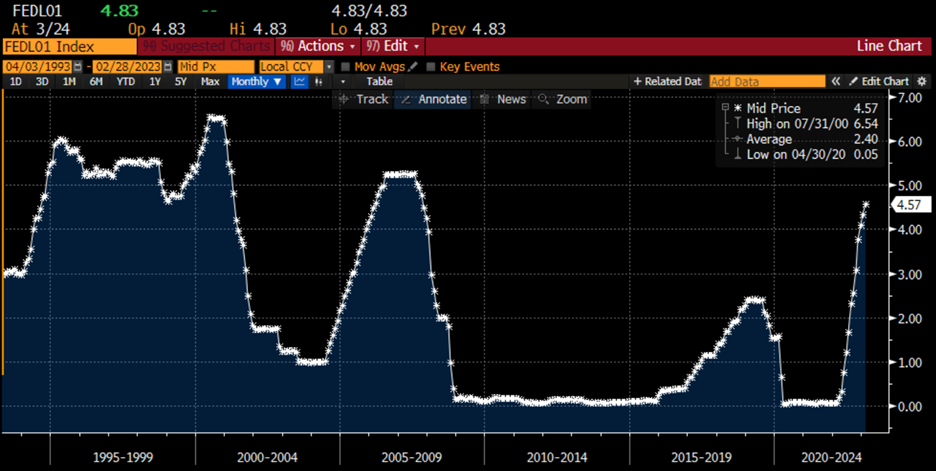As I write this, mid-morning on Monday, we are seeing some relative calm return to global markets. European equities traded higher, shrugging off Friday’s concerns about Deutsche Bank (DB) credit default swaps (CDS). US markets, having largely put those concerns behind them by Friday afternoon, are more muted, but broadly positive. Importantly, we see 2-year yields rising by 18 basis points, indicating some easing of systemic concerns.
Relative calm is good for skittish markets. We can be hopeful that the worst of the recent banking crisis is behind us, but that requires a bit of time and faith. No one rings a bell and declares “Banking crisis over!” It is normal to feel incrementally safer, and adjust our investments accordingly. Those who were active during 2008’s global financial crisis (GFC) remember that events can unfold in unpredictable spurts, making them more wary of piling back into risk assets at the slightest sign of safety, but in any event, we all crave clarity and stability.
Although markets seem to be stabilizing, we still see a substantial amount of concern being priced into short-term fixed income markets. Fed Funds futures are currently implying a 50/50 chance for a 25 basis point rate hike at the May FOMC meeting. That means we are either at peak rates now, or will seem them by May. From that point on, we start to see rate cuts being priced in. Rates in July are projected to be lower than today, and at 4.17% by December. That implies we will see a net of 2-3 cuts by the end of the year.
Yet there is little historical precedent for the FOMC to cut rates immediately after finishing a hiking cycle. It is far more typical for rates to plateau for about 6 months to a year before cuts begin, as evidenced in the graph below:
Effective Federal Funds Rate, 30-years, Monthly Data

Source: Bloomberg
Looking at that history, it is quite clear that the most recent FOMC dot plot, which shows a median estimate for year-end rates at 5.1%, reflects that knowledge. We need to go back to 1995 to see a time when the Fed quickly reversed a hike, and even then it was followed by long plateaus (at levels above today’s, mind you). If I recall correctly, a Mexican debt crisis precipitated that quick change. A similar sort of crisis could precipitate a similar about face, as could an abrupt
Do you reasonably expect the FOMC to say, “Sure, we’ve whipped inflation, so let’s start cutting rates.”? Of course not. Thus, it would require some sort of major event to spur the Fed to reverse course thoroughly and abruptly. Furthermore, that event would have to either be deflationary on its own, or sufficiently concerning that the “stable prices” portion of the Fed’s dual mandate takes a back seat to “full employment.” Please let me know if you have any benign ways that this can occur, but I can only come up with things like recession or some sort of financial crisis.
How then do we wrap our minds around the continued sanguine nature of the stock market with the nervousness expressed by fixed income markets? It’s cognitive dissonance and quite difficult to reconcile. One thing we see is greater concentration in stocks that are thought to be especially safe. The problem is that those are becoming crowded trades. As of today, Apple (AAPL) and Microsoft (MSFT), two well-managed companies with very stable earnings streams (plus a whiff of AI enthusiasm), combine to make up 25% of the NASDAQ 100 Index (NDX) and about 13% of the S&P 500 Index (SPX). That’s just two stocks! Narrowing leadership rarely leads to good outcomes for equities in general.
Can we work our way of this conundrum? Sure. If we get disinflation, no recession, calmer fixed income, and broadening stock market participation, then that could lead to us into a wonderful outcome. Do you see that as your base case? If so, that’s quite a parlay. If not, then please reassess the risks you carry in your portfolio and see if they truly line up with the risks that large segments of the markets imply.
Disclosure: Interactive Brokers
The analysis in this material is provided for information only and is not and should not be construed as an offer to sell or the solicitation of an offer to buy any security. To the extent that this material discusses general market activity, industry or sector trends or other broad-based economic or political conditions, it should not be construed as research or investment advice. To the extent that it includes references to specific securities, commodities, currencies, or other instruments, those references do not constitute a recommendation by IBKR to buy, sell or hold such investments. This material does not and is not intended to take into account the particular financial conditions, investment objectives or requirements of individual customers. Before acting on this material, you should consider whether it is suitable for your particular circumstances and, as necessary, seek professional advice.
The views and opinions expressed herein are those of the author and do not necessarily reflect the views of Interactive Brokers, its affiliates, or its employees.




















Join The Conversation
For specific platform feedback and suggestions, please submit it directly to our team using these instructions.
If you have an account-specific question or concern, please reach out to Client Services.
We encourage you to look through our FAQs before posting. Your question may already be covered!